By William Park 4th January 2017
Dug for an underground ‘shadow factory’ for aircraft during World War Two, the Drakelow tunnels were re-purposed as a nuclear bunker to be used by the UK government. We went inside.
D
Deep beneath a hill in the Worcestershire countryside, about 20 miles west of Birmingham, lie a series of hidden tunnels. Once home to a secret aeroplane factory during World War Two, they were later repurposed to protect the UK in the event of a nuclear war: it’s from here that the government would have continued to run the country.
“This would have been the last resort of the UK government,” says Michael Scott, a volunteer with the Drakelow Preservation Trust, which is restoring the site. The Trust’s aim is to reopen parts of the tunnels as a museum to preserve their history in World War Two and the Cold War. But the organisation remains some years away from finishing the work, and without much funding, the volunteers are restricted mostly to repainting walls.
Given how important they once were, it seems surprising that the tunnels are all but forgotten today.
When the UK came under siege, the government needed to continue production of tanks, aircraft and ammunition. The solution was to build underground factories – also called shadow factories – away from large cities
When cities across the UK came under siege during the war, the government needed to find a way to continue production of tanks, aircraft and ammunition. The solution was to build underground factories – also called shadow factories – away from large cities. The Drakelow Tunnels housed one of them. And the same remoteness and fortress-like qualities that made Drakelow an effective underground aircraft factory would later make it the location of choice for responding to nuclear attack in Britain.
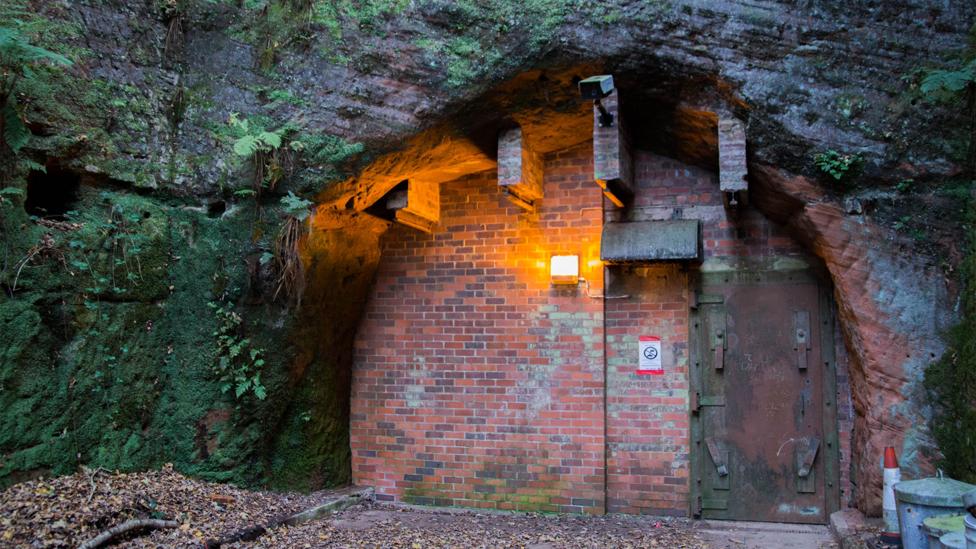
The Adit A entrance, used when the tunnels were turned into a nuclear bunker, is the entrance which volunteers use today (Credit: William Park)
Today, the entrance used by Scott and the other volunteers is called Adit A; it’s where the security office would have stood. Most of the hillside around the entrance is bare, revealing a sandstone mass towering above us that would have made this site virtually bomb-proof in World War Two.
Adit A shows many signs of the alterations that were made to Drakelow Tunnels to retrofit it for use as a nuclear bunker – including covered air vents that would have protected those inside from fallout. Through the heavy steel door, visitors would have had to strip, incinerate their clothes and shower as they decontaminated themselves.
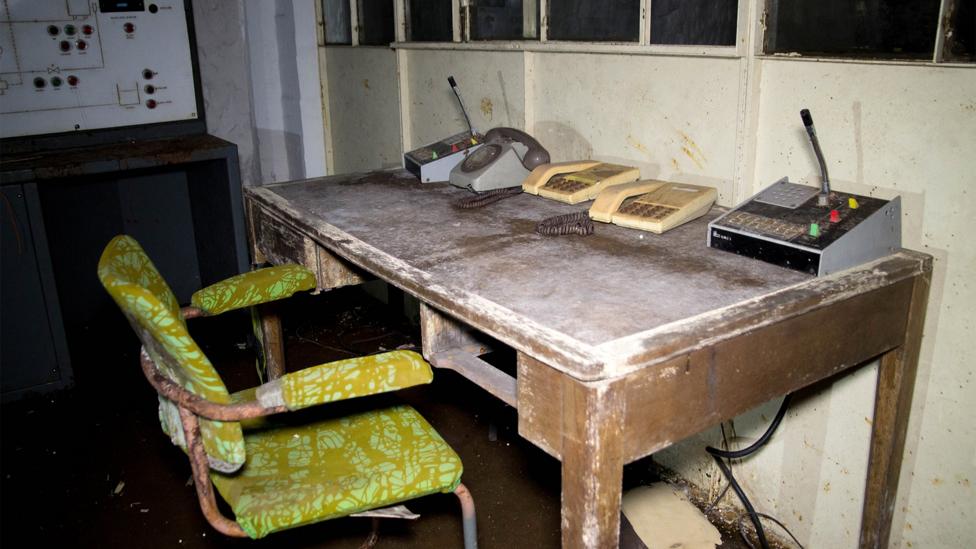
When Drakelow Tunnels served as a nuclear bunker, employees worked in rooms like this one, which was a former Regional Seats of Government (RSG) office (Credit: William Park)
One of the first rooms inside contains the water tanks. They store three months’ drinking water which to this day remains untouched. Like much in Drakelow, if it couldn’t be removed when the site was decommissioned, it was left behind.
It makes for an eerie tribute to a once essential line in the UK’s defences.
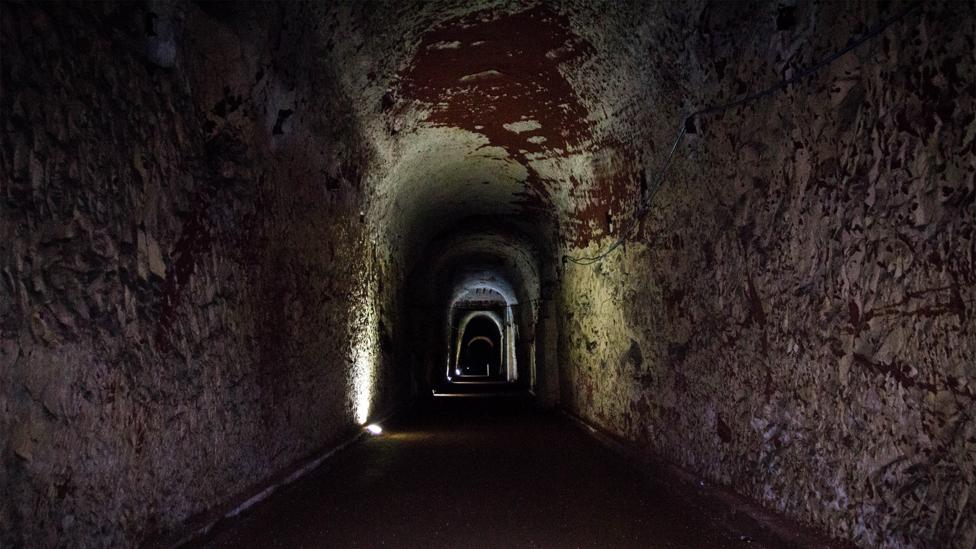
Tunnel 1 has had its air ducts removed, showing its full height; the tunnels are easily big enough to fit a double-decker bus (Credit: William Park)
Construction of the tunnels began in June 1941; the factory went into full production in May 1943. At peak production, 700 employees worked for Rover, manufacturing parts for the Bristol Aeroplane Company who used them in engines that went into Bristol Beaufighters – a multipurpose aircraft that could be used as a fighter or bomber. The Bristol Aeroplane Company used several sites in the UK, each manufacturing components of aircraft that were then distributed to other plants to be assembled together.
Deep impact
As you might expect from an assembly line, never mind one confined underground, Drakelow was designed for efficiency. Walking around the 250,000sqft site, it’s hard not to notice the number of toilets in each tunnel. “The idea was to make sure that workers spent as little time as possible going to the toilet,” says Scott. “They wanted to keep employees on the shop floor for as long as possible so they could keep churning out parts.”
The workers ate underground, too – a canteen capable of feeding 700 employees sits in the middle of the site. Ovens, potato peelers, dough mixers and hotplates rust slowly in the damp air.
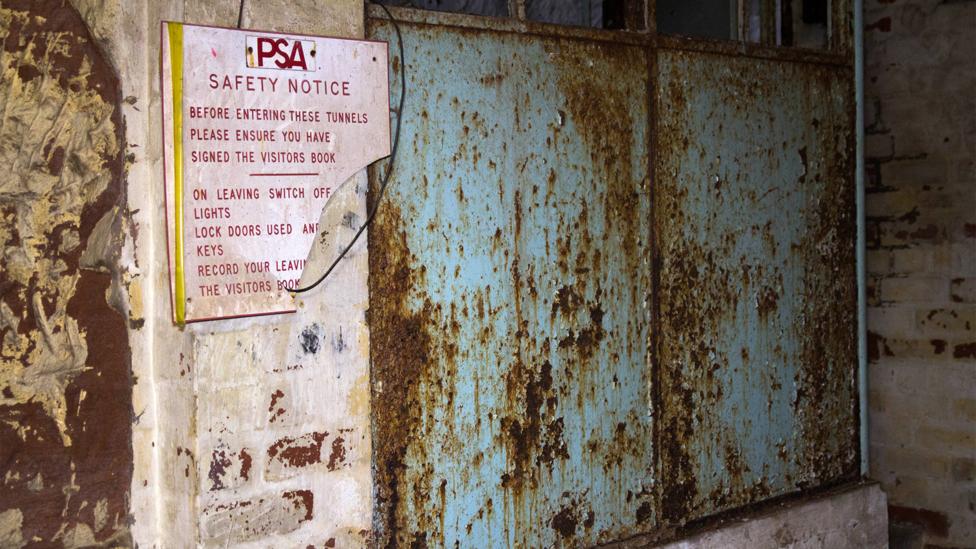
A safety announcement remains tacked to the entrance for employees of the aircraft factory (Credit: William Park)
In some places, the tunnels are lined with steel; the metal encasing stands a foot or so away from the bare rock. It’s here that the hottest machine work would have been conducted. Melting metal raised the temperature inside the tunnels, causing the rock to expand during working hours and to contract at night as they cooled, increasing the risk of rock fall. However, the steel shields absorbed most of the heat, expanding in a controlled way – and had any rock fallen away from the ceiling, the workers would have been protected.
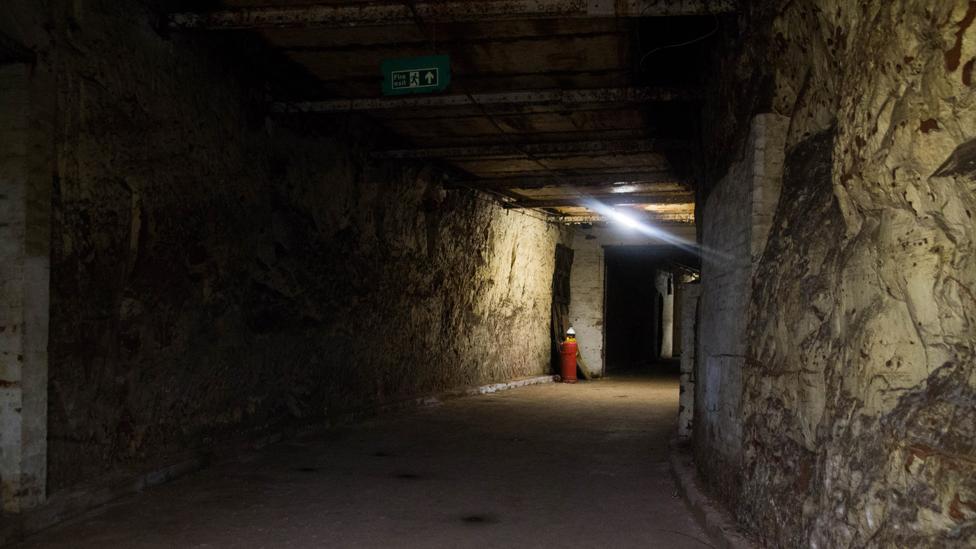
The main entrance to the factory is curved so that if a bomb dropped outside, the blast would be deflected around the corner and the energy would dissipate (Credit: William Park)
There are examples of similar subterranean shadow factories in Germany, too. The largest was Mittelwerk, Kohnstein, which produced V-1 and V-2 bombs from 1943 to 1945. The move underground was a direct result of the destruction of other, above-ground V-2 production plants, like Peenemunde in northern Germany. Unlike Drakelow, Mittelwerk was left in ruins after the war.
Perhaps the most intriguing underground network of Nazi military tunnels is the series of seven structures that make up Project Riese. Buried in the Owl Mountains – then part of Germany but now in south-west Poland near the Czech border – these sites were never finished and documents about their full purpose seem to have been destroyed.
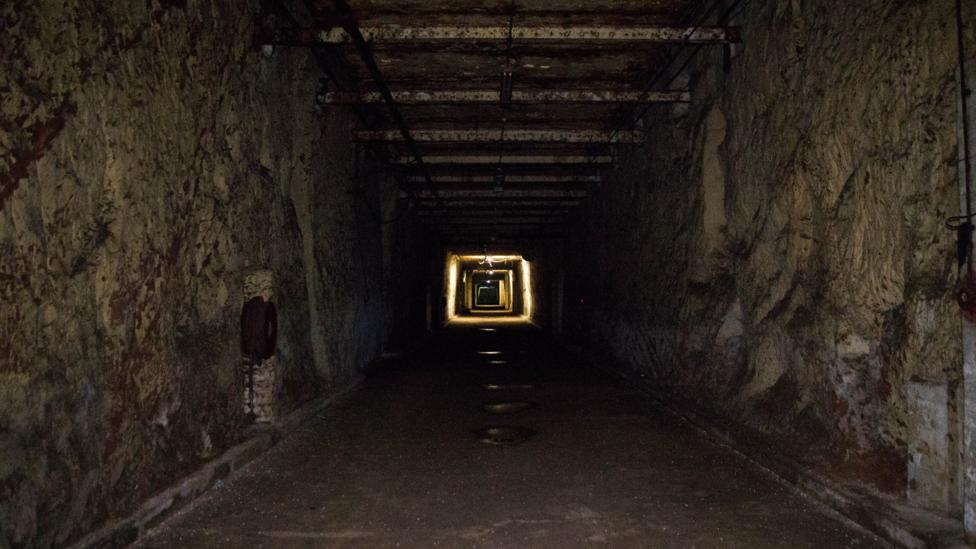
One of the main tunnels running through Drakelow (Credit: William Park)
Much smaller than Drakelow, but very similar in design, six of the structures were probably built to be used as factories or ammunition stores. But as they were cut deep into the hard gneiss rock of the Owl Mountains, their construction would have been much more challenging than digging into the relatively soft sandstone around Drakelow. Most of the hard labour was completed by prisoners of war from the surrounding concentration camps of Walbrzych County.
The centrepiece of Project Riese would have been a far older building – the 13th-Century Ksiaz Castle in the city of Walbryzch. The last private owners were the Hochberg family, who lost possession of the castle in 1944 to the Nazi party after falling into debt. To make the castle suitable for military occupation, two levels of tunnels were bored 53m (175ft) under the courtyard and joined to the train line at Lubiechow by a narrow gauge railway – allowing direct access by rail into the castle. It’s thought that the site would have become a headquarters for Project Riese, from which all six of the factories could be managed – and there is some suggestion that the grand castle would have been used as one of Adolf Hitler’s Fuhrer Headquarters, although with the war drawing to a close, none of this was ever realised.
Cold comfort
Top-secret military construction did not end with World War Two. In 1949, as the Cold War bloomed, the UK government began to build 15 fortified war rooms across the country.
But in the case of the much bigger threat of a nuclear attack, these buildings would not have been enough to protect their inhabitants. They were too small, making them unable to support a workforce for the extended period of time they’d need to remain indoors to avoid the fallout of a nuclear explosion. They also were built too close to the major cities which could have been a target for an attack: five were built in London, for example.
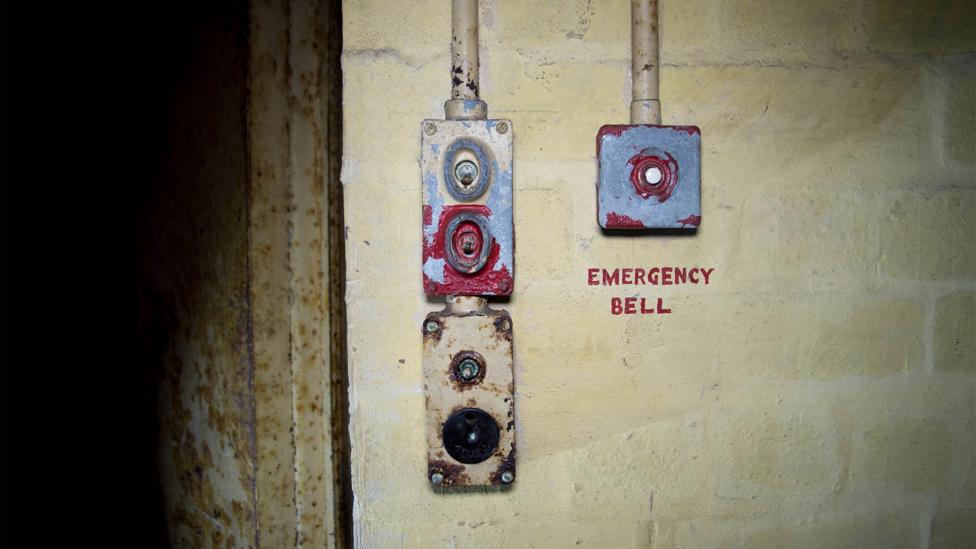
An emergency bell inside Drakelow's ‘safe room’, which has no windows and a heavy steel door (Credit: William Park)
Having seen the effect of a nuclear attack in Japan, the British government commissioned the Strath Committee, led by head of the Central War Plans Secretariat William Strath, to analyse the potential effects of a nuclear attack on the UK. In 1955 the committee published the Strath Report which found that even a ‘limited’ attack would have devastating consequences. Food and water would be contaminated, the NHS would be overwhelmed with four million serious casualties and 12 million deaths, and industry would shut down. In short, the “social and economic fabric of the country [would be] destroyed”.
Even a ‘limited’ attack would have devastating consequences
Strath recommended the UK invest in a network of nuclear bunkers to protect the population. However, estimates put the cost of such an enormous series of bunkers at £1.25bn (equal to £30.88bn in 2016).
The government’s new Working Party on the Machinery of Government in War chaired by Sir Thomas Padmore sought an alternative. With such a prohibitively expensive cost, a compromise was reached. Padmore and Strath recognised the need to build multiple headquarters underground. Some of the bunkers would hold people who would continue to be run the country as best as possible – but wouldn’t accommodate members of the public.
In the event of a nuclear attack on London, power would pass to local heads of government who would control fragments of the UK from inside their nuclear bunker. These bunkers would become Regional Seats of Government (RSG) – where a staff of anywhere from a few dozen to a few hundred people would continue the administrative work of the area. From here, public service notices could be broadcast from BBC studios deep in the bunkers to the public outside, keeping them up to date.
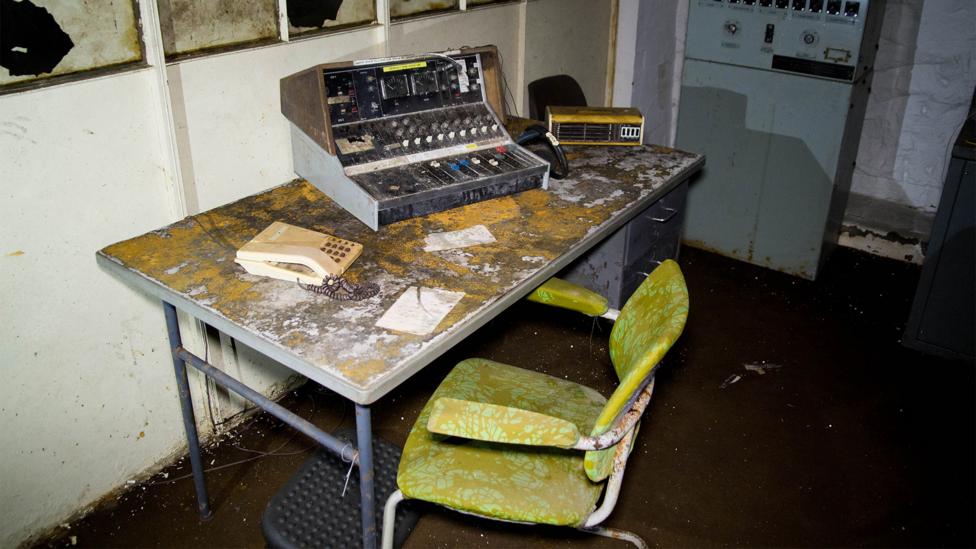
In case of attack, announcements would have been broadcast from a machine like this one, which was donated by a BBC Radio station and is not the original (Credit: William Park)
To find suitable locations for these bunkers, Padmore looked for sites far enough away from populated areas to not be at risk of a direct hit, deep enough underground to protect the inhabitants from nuclear fallout but still practical enough to support life for months at a time. The Drakelow tunnels were a perfect fit.
“They would have told the public to get in their bathtubs – or whatever the advice was back then,” says Scott. “Chances are, anyone on the outside listening to the broadcasts were in a far worse state than anyone on the inside. But this is how the public would have been reassured that the government was still running the country.
They would have told the public to get in their bathtubs – or whatever the advice was back then – Michael Scott
“If one regional government headquarters was taken out, then there were several others that could carry on. They could take over and let everyone know what was happening. But they were never used.”
The BBC studio at Drakelow has now completely rotten through. Soundproofing panels fall from the walls and the ceiling piling into a soft, damp carpet on the floor. It’s the only part of the tunnels where your voice doesn’t echo.
“So much of what was left on the site has rotten,” says Scott. “There’s very little here that doesn’t need replacing.”
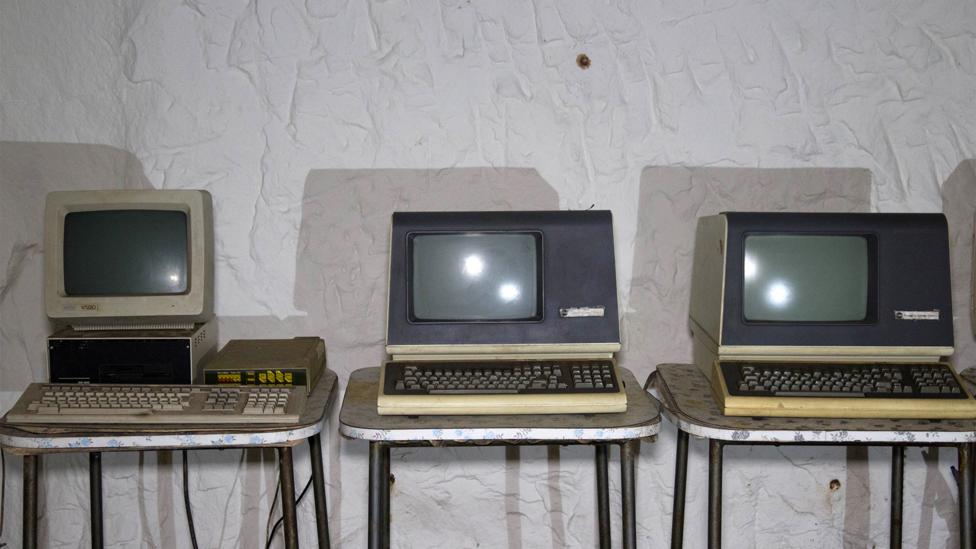
Old computers sit in the RSG offices (Credit: William Park)
The air inside the tunnels is very damp. It’s not cold – it’s actually several degrees warmer than the outside – but even in their heyday, the tunnels would have required constant dehumidification. In Tunnel 1, the furthest tunnel from where we began, we climb into one of the fans that powered the air conditioning system for the whole site; the vent is big enough to stand in.
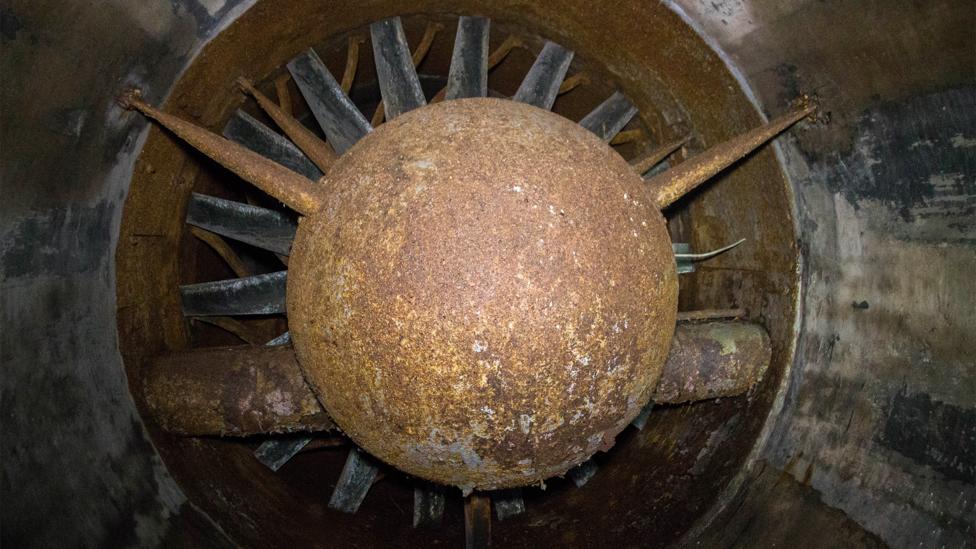
Inside one of the extractor fans; the vent is easily big enough to stand up in (Credit: William Park)
Today, keeping the tunnels dry is an even bigger challenge than it was then: the main generator on the site has broken and the volunteers rely exclusively on the back-up generator to power their lights and dehumidifier.
Only a fraction of the entire site was converted for use as a Regional Seat of Government. Most of the factory remained empty behind bricked-up walls, including the main kitchen. During the retrofitting, a new, smaller kitchen was built on the RSG side of the brick divide and former factory offices became dormitories with military bunk beds. During the latest period of Drakelow’s service, computers were installed in the offices.
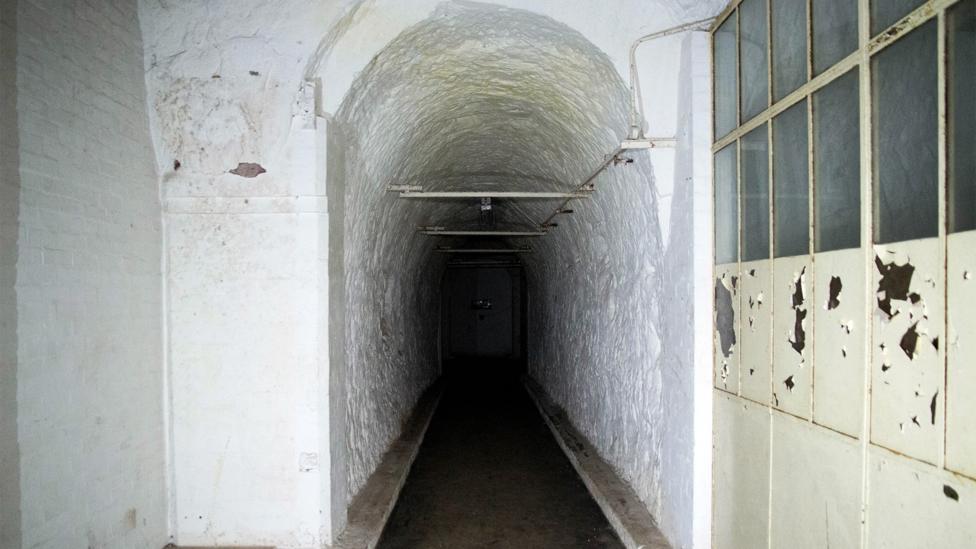
A tunnel leading from the RSG offices to a bricked-up wall; behind here, the rest of the factory lies empty (Credit: William Park)
“There’s still so much about the site that we don’t know,” says Scott as we pause next to a bricked-up tunnel entrance. “I’d love to take a sledgehammer to this wall and find out what’s behind it. But this is a military site and it would have been blocked for a very good reason. It might not be safe – or it might be that people died in this tunnel and couldn’t be rescued. We might never want to know what’s behind here.”
There’s still so much about the site that we don’t know… We might never want to know – Scott
From 1958 until 1980, Drakelow was a Regional Seat of Government on standby – in case of nuclear attack. By the 1980s, as the Cold War dragged on and the public became increasingly frustrated with the British nuclear programme, regular protests were held outside the main gate. In 1980, Drakelow became a Regional Government Headquarters – a name change that meant a reduced staff but essentially the same function. But it wasn’t until 1993 that the site was sold off. It has been privately owned since, but for the most part has remained unchanged.
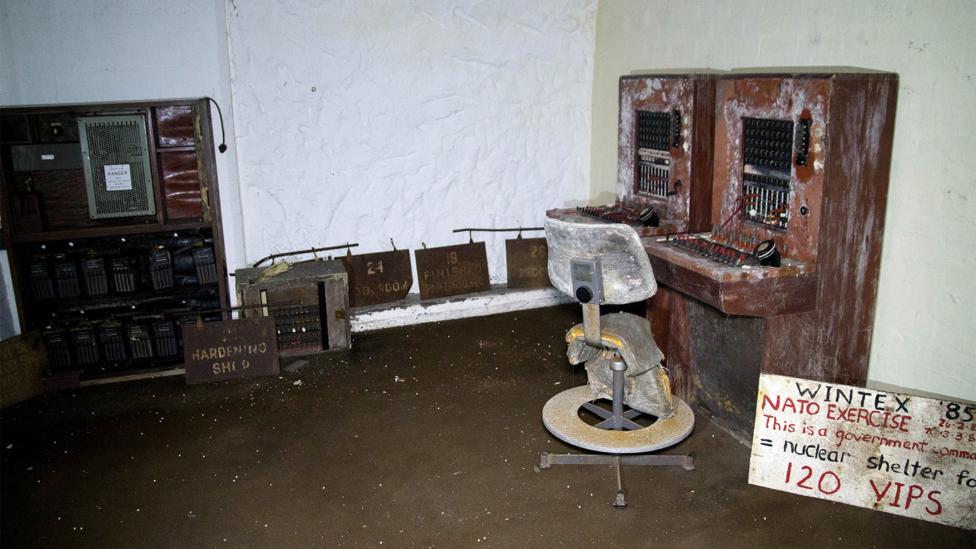
One of the RSG offices still has a sign from a 1985 protest in one corner (Credit: William Park)
“We would love to reopen the site to the public,” says Scott. “It’s one of very few sites in the UK with such an important involvement in both World War Two and the Cold War. There are a few shadow factories, but not many that are easily accessible or that weren’t destroyed after the war, or that are as interesting as Drakelow. And there are several Regional Seats of Government – some of which are now museums – but they’re either much smaller or purpose-built, so to us are much less interesting.”
Stepping back outside, there’s little to suggest the complete extent of the Drakelow tunnels. A few innocuous entrances like Adit A can be found in the surrounding countryside; on weekends, there will be some cars parked outside. But there is nothing to suggest that this was once a constant conveyor belt of aircraft parts – and the last resort of the British government.
Dug for an underground ‘shadow factory’ for aircraft during World War Two, the Drakelow tunnels were re-purposed as a nuclear bunker to be used by the UK government. We went inside.
D
Deep beneath a hill in the Worcestershire countryside, about 20 miles west of Birmingham, lie a series of hidden tunnels. Once home to a secret aeroplane factory during World War Two, they were later repurposed to protect the UK in the event of a nuclear war: it’s from here that the government would have continued to run the country.
“This would have been the last resort of the UK government,” says Michael Scott, a volunteer with the Drakelow Preservation Trust, which is restoring the site. The Trust’s aim is to reopen parts of the tunnels as a museum to preserve their history in World War Two and the Cold War. But the organisation remains some years away from finishing the work, and without much funding, the volunteers are restricted mostly to repainting walls.
Given how important they once were, it seems surprising that the tunnels are all but forgotten today.
When the UK came under siege, the government needed to continue production of tanks, aircraft and ammunition. The solution was to build underground factories – also called shadow factories – away from large cities
When cities across the UK came under siege during the war, the government needed to find a way to continue production of tanks, aircraft and ammunition. The solution was to build underground factories – also called shadow factories – away from large cities. The Drakelow Tunnels housed one of them. And the same remoteness and fortress-like qualities that made Drakelow an effective underground aircraft factory would later make it the location of choice for responding to nuclear attack in Britain.

The Adit A entrance, used when the tunnels were turned into a nuclear bunker, is the entrance which volunteers use today (Credit: William Park)
Today, the entrance used by Scott and the other volunteers is called Adit A; it’s where the security office would have stood. Most of the hillside around the entrance is bare, revealing a sandstone mass towering above us that would have made this site virtually bomb-proof in World War Two.
Adit A shows many signs of the alterations that were made to Drakelow Tunnels to retrofit it for use as a nuclear bunker – including covered air vents that would have protected those inside from fallout. Through the heavy steel door, visitors would have had to strip, incinerate their clothes and shower as they decontaminated themselves.

When Drakelow Tunnels served as a nuclear bunker, employees worked in rooms like this one, which was a former Regional Seats of Government (RSG) office (Credit: William Park)
One of the first rooms inside contains the water tanks. They store three months’ drinking water which to this day remains untouched. Like much in Drakelow, if it couldn’t be removed when the site was decommissioned, it was left behind.
It makes for an eerie tribute to a once essential line in the UK’s defences.

Tunnel 1 has had its air ducts removed, showing its full height; the tunnels are easily big enough to fit a double-decker bus (Credit: William Park)
Construction of the tunnels began in June 1941; the factory went into full production in May 1943. At peak production, 700 employees worked for Rover, manufacturing parts for the Bristol Aeroplane Company who used them in engines that went into Bristol Beaufighters – a multipurpose aircraft that could be used as a fighter or bomber. The Bristol Aeroplane Company used several sites in the UK, each manufacturing components of aircraft that were then distributed to other plants to be assembled together.
Deep impact
As you might expect from an assembly line, never mind one confined underground, Drakelow was designed for efficiency. Walking around the 250,000sqft site, it’s hard not to notice the number of toilets in each tunnel. “The idea was to make sure that workers spent as little time as possible going to the toilet,” says Scott. “They wanted to keep employees on the shop floor for as long as possible so they could keep churning out parts.”
The workers ate underground, too – a canteen capable of feeding 700 employees sits in the middle of the site. Ovens, potato peelers, dough mixers and hotplates rust slowly in the damp air.

A safety announcement remains tacked to the entrance for employees of the aircraft factory (Credit: William Park)
In some places, the tunnels are lined with steel; the metal encasing stands a foot or so away from the bare rock. It’s here that the hottest machine work would have been conducted. Melting metal raised the temperature inside the tunnels, causing the rock to expand during working hours and to contract at night as they cooled, increasing the risk of rock fall. However, the steel shields absorbed most of the heat, expanding in a controlled way – and had any rock fallen away from the ceiling, the workers would have been protected.

The main entrance to the factory is curved so that if a bomb dropped outside, the blast would be deflected around the corner and the energy would dissipate (Credit: William Park)
There are examples of similar subterranean shadow factories in Germany, too. The largest was Mittelwerk, Kohnstein, which produced V-1 and V-2 bombs from 1943 to 1945. The move underground was a direct result of the destruction of other, above-ground V-2 production plants, like Peenemunde in northern Germany. Unlike Drakelow, Mittelwerk was left in ruins after the war.
Perhaps the most intriguing underground network of Nazi military tunnels is the series of seven structures that make up Project Riese. Buried in the Owl Mountains – then part of Germany but now in south-west Poland near the Czech border – these sites were never finished and documents about their full purpose seem to have been destroyed.

One of the main tunnels running through Drakelow (Credit: William Park)
Much smaller than Drakelow, but very similar in design, six of the structures were probably built to be used as factories or ammunition stores. But as they were cut deep into the hard gneiss rock of the Owl Mountains, their construction would have been much more challenging than digging into the relatively soft sandstone around Drakelow. Most of the hard labour was completed by prisoners of war from the surrounding concentration camps of Walbrzych County.
The centrepiece of Project Riese would have been a far older building – the 13th-Century Ksiaz Castle in the city of Walbryzch. The last private owners were the Hochberg family, who lost possession of the castle in 1944 to the Nazi party after falling into debt. To make the castle suitable for military occupation, two levels of tunnels were bored 53m (175ft) under the courtyard and joined to the train line at Lubiechow by a narrow gauge railway – allowing direct access by rail into the castle. It’s thought that the site would have become a headquarters for Project Riese, from which all six of the factories could be managed – and there is some suggestion that the grand castle would have been used as one of Adolf Hitler’s Fuhrer Headquarters, although with the war drawing to a close, none of this was ever realised.
Cold comfort
Top-secret military construction did not end with World War Two. In 1949, as the Cold War bloomed, the UK government began to build 15 fortified war rooms across the country.
But in the case of the much bigger threat of a nuclear attack, these buildings would not have been enough to protect their inhabitants. They were too small, making them unable to support a workforce for the extended period of time they’d need to remain indoors to avoid the fallout of a nuclear explosion. They also were built too close to the major cities which could have been a target for an attack: five were built in London, for example.

An emergency bell inside Drakelow's ‘safe room’, which has no windows and a heavy steel door (Credit: William Park)
Having seen the effect of a nuclear attack in Japan, the British government commissioned the Strath Committee, led by head of the Central War Plans Secretariat William Strath, to analyse the potential effects of a nuclear attack on the UK. In 1955 the committee published the Strath Report which found that even a ‘limited’ attack would have devastating consequences. Food and water would be contaminated, the NHS would be overwhelmed with four million serious casualties and 12 million deaths, and industry would shut down. In short, the “social and economic fabric of the country [would be] destroyed”.
Even a ‘limited’ attack would have devastating consequences
Strath recommended the UK invest in a network of nuclear bunkers to protect the population. However, estimates put the cost of such an enormous series of bunkers at £1.25bn (equal to £30.88bn in 2016).
The government’s new Working Party on the Machinery of Government in War chaired by Sir Thomas Padmore sought an alternative. With such a prohibitively expensive cost, a compromise was reached. Padmore and Strath recognised the need to build multiple headquarters underground. Some of the bunkers would hold people who would continue to be run the country as best as possible – but wouldn’t accommodate members of the public.
In the event of a nuclear attack on London, power would pass to local heads of government who would control fragments of the UK from inside their nuclear bunker. These bunkers would become Regional Seats of Government (RSG) – where a staff of anywhere from a few dozen to a few hundred people would continue the administrative work of the area. From here, public service notices could be broadcast from BBC studios deep in the bunkers to the public outside, keeping them up to date.

In case of attack, announcements would have been broadcast from a machine like this one, which was donated by a BBC Radio station and is not the original (Credit: William Park)
To find suitable locations for these bunkers, Padmore looked for sites far enough away from populated areas to not be at risk of a direct hit, deep enough underground to protect the inhabitants from nuclear fallout but still practical enough to support life for months at a time. The Drakelow tunnels were a perfect fit.
“They would have told the public to get in their bathtubs – or whatever the advice was back then,” says Scott. “Chances are, anyone on the outside listening to the broadcasts were in a far worse state than anyone on the inside. But this is how the public would have been reassured that the government was still running the country.
They would have told the public to get in their bathtubs – or whatever the advice was back then – Michael Scott
“If one regional government headquarters was taken out, then there were several others that could carry on. They could take over and let everyone know what was happening. But they were never used.”
The BBC studio at Drakelow has now completely rotten through. Soundproofing panels fall from the walls and the ceiling piling into a soft, damp carpet on the floor. It’s the only part of the tunnels where your voice doesn’t echo.
“So much of what was left on the site has rotten,” says Scott. “There’s very little here that doesn’t need replacing.”

Old computers sit in the RSG offices (Credit: William Park)
The air inside the tunnels is very damp. It’s not cold – it’s actually several degrees warmer than the outside – but even in their heyday, the tunnels would have required constant dehumidification. In Tunnel 1, the furthest tunnel from where we began, we climb into one of the fans that powered the air conditioning system for the whole site; the vent is big enough to stand in.

Inside one of the extractor fans; the vent is easily big enough to stand up in (Credit: William Park)
Today, keeping the tunnels dry is an even bigger challenge than it was then: the main generator on the site has broken and the volunteers rely exclusively on the back-up generator to power their lights and dehumidifier.
Only a fraction of the entire site was converted for use as a Regional Seat of Government. Most of the factory remained empty behind bricked-up walls, including the main kitchen. During the retrofitting, a new, smaller kitchen was built on the RSG side of the brick divide and former factory offices became dormitories with military bunk beds. During the latest period of Drakelow’s service, computers were installed in the offices.

A tunnel leading from the RSG offices to a bricked-up wall; behind here, the rest of the factory lies empty (Credit: William Park)
“There’s still so much about the site that we don’t know,” says Scott as we pause next to a bricked-up tunnel entrance. “I’d love to take a sledgehammer to this wall and find out what’s behind it. But this is a military site and it would have been blocked for a very good reason. It might not be safe – or it might be that people died in this tunnel and couldn’t be rescued. We might never want to know what’s behind here.”
There’s still so much about the site that we don’t know… We might never want to know – Scott
From 1958 until 1980, Drakelow was a Regional Seat of Government on standby – in case of nuclear attack. By the 1980s, as the Cold War dragged on and the public became increasingly frustrated with the British nuclear programme, regular protests were held outside the main gate. In 1980, Drakelow became a Regional Government Headquarters – a name change that meant a reduced staff but essentially the same function. But it wasn’t until 1993 that the site was sold off. It has been privately owned since, but for the most part has remained unchanged.

One of the RSG offices still has a sign from a 1985 protest in one corner (Credit: William Park)
“We would love to reopen the site to the public,” says Scott. “It’s one of very few sites in the UK with such an important involvement in both World War Two and the Cold War. There are a few shadow factories, but not many that are easily accessible or that weren’t destroyed after the war, or that are as interesting as Drakelow. And there are several Regional Seats of Government – some of which are now museums – but they’re either much smaller or purpose-built, so to us are much less interesting.”
Stepping back outside, there’s little to suggest the complete extent of the Drakelow tunnels. A few innocuous entrances like Adit A can be found in the surrounding countryside; on weekends, there will be some cars parked outside. But there is nothing to suggest that this was once a constant conveyor belt of aircraft parts – and the last resort of the British government.



